Speech Pathology: Report on AAC Guidelines and WHS Policies
VerifiedAdded on 2023/06/11
|22
|4765
|136
Report
AI Summary
This assignment provides a comprehensive overview of speech pathology, focusing on Augmentative and Alternative Communication (AAC) guidelines and Work Health and Safety (WHS) policies. The first part details AAC, including its types (no-tech, low-tech, high-tech), necessity for various congenital, developmental, and acquired conditions, and different communication assistance methods like color coding, facilitated communication, and vocabulary choice. It also presents typical AAC systems such as gesturing, communication boards, spelling, and speech generation devices, along with the criteria speech pathologists use for device selection. The second part reports on the importance of WHS policies in allied health, emphasizing duty of care, informed consent, risk identification, documentation, manual handling, duty to colleagues, and reporting of unfair incidents, all within the ethical and legal frameworks of speech pathology. Desklib offers this assignment as a valuable resource for students, alongside a wide array of study tools and solved assignments.
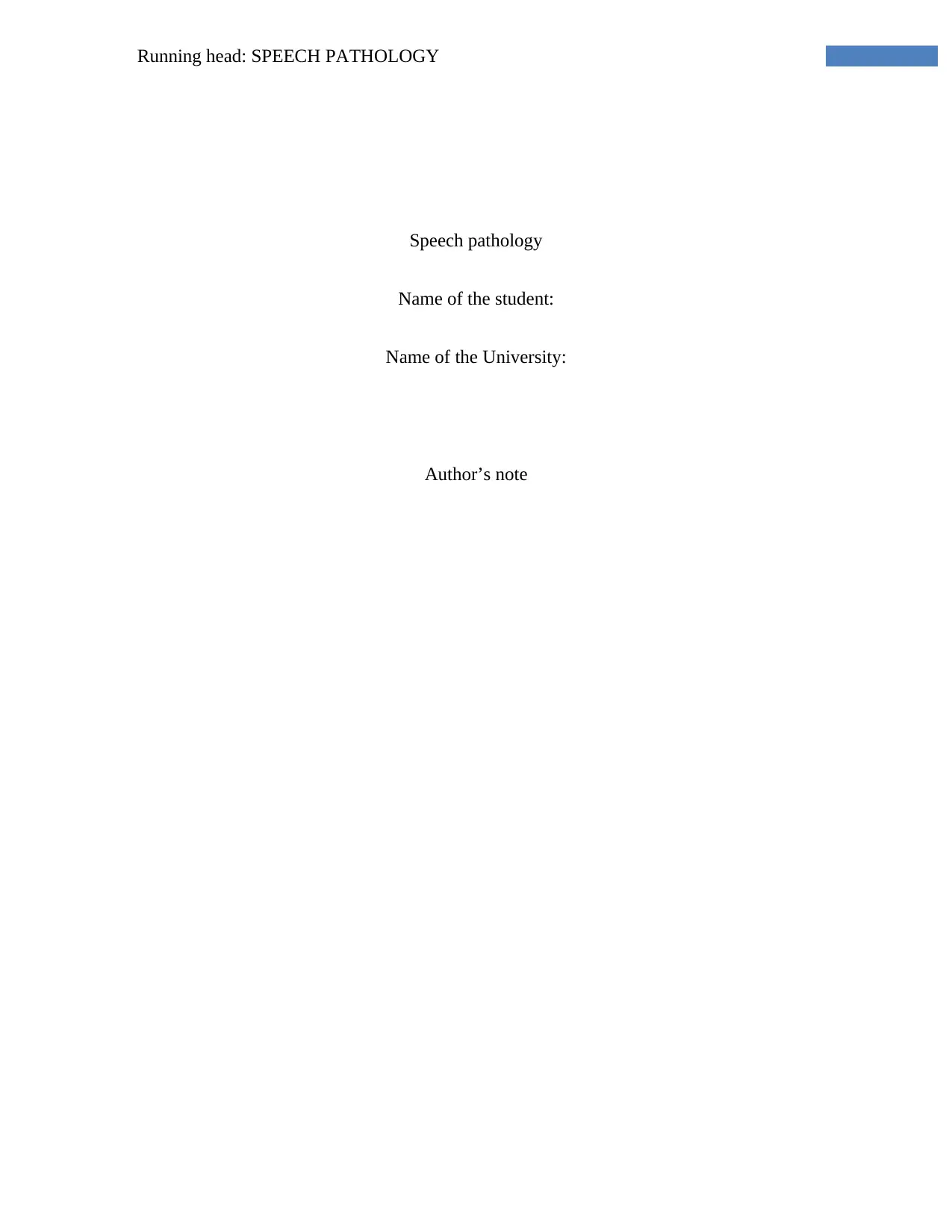
Running head: SPEECH PATHOLOGY
Speech pathology
Name of the student:
Name of the University:
Author’s note
Speech pathology
Name of the student:
Name of the University:
Author’s note
Paraphrase This Document
Need a fresh take? Get an instant paraphrase of this document with our AI Paraphraser
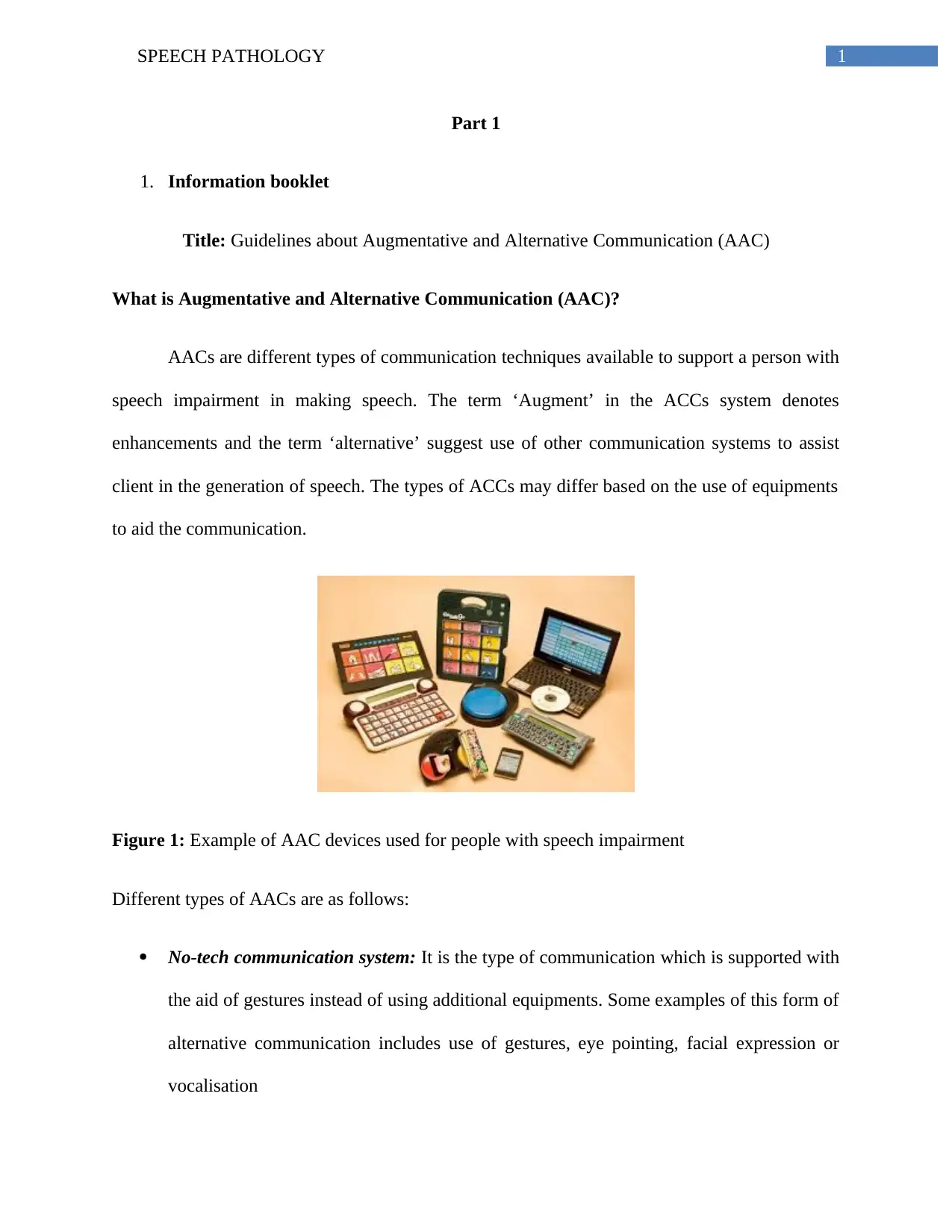
1SPEECH PATHOLOGY
Part 1
1. Information booklet
Title: Guidelines about Augmentative and Alternative Communication (AAC)
What is Augmentative and Alternative Communication (AAC)?
AACs are different types of communication techniques available to support a person with
speech impairment in making speech. The term ‘Augment’ in the ACCs system denotes
enhancements and the term ‘alternative’ suggest use of other communication systems to assist
client in the generation of speech. The types of ACCs may differ based on the use of equipments
to aid the communication.
Figure 1: Example of AAC devices used for people with speech impairment
Different types of AACs are as follows:
No-tech communication system: It is the type of communication which is supported with
the aid of gestures instead of using additional equipments. Some examples of this form of
alternative communication includes use of gestures, eye pointing, facial expression or
vocalisation
Part 1
1. Information booklet
Title: Guidelines about Augmentative and Alternative Communication (AAC)
What is Augmentative and Alternative Communication (AAC)?
AACs are different types of communication techniques available to support a person with
speech impairment in making speech. The term ‘Augment’ in the ACCs system denotes
enhancements and the term ‘alternative’ suggest use of other communication systems to assist
client in the generation of speech. The types of ACCs may differ based on the use of equipments
to aid the communication.
Figure 1: Example of AAC devices used for people with speech impairment
Different types of AACs are as follows:
No-tech communication system: It is the type of communication which is supported with
the aid of gestures instead of using additional equipments. Some examples of this form of
alternative communication includes use of gestures, eye pointing, facial expression or
vocalisation
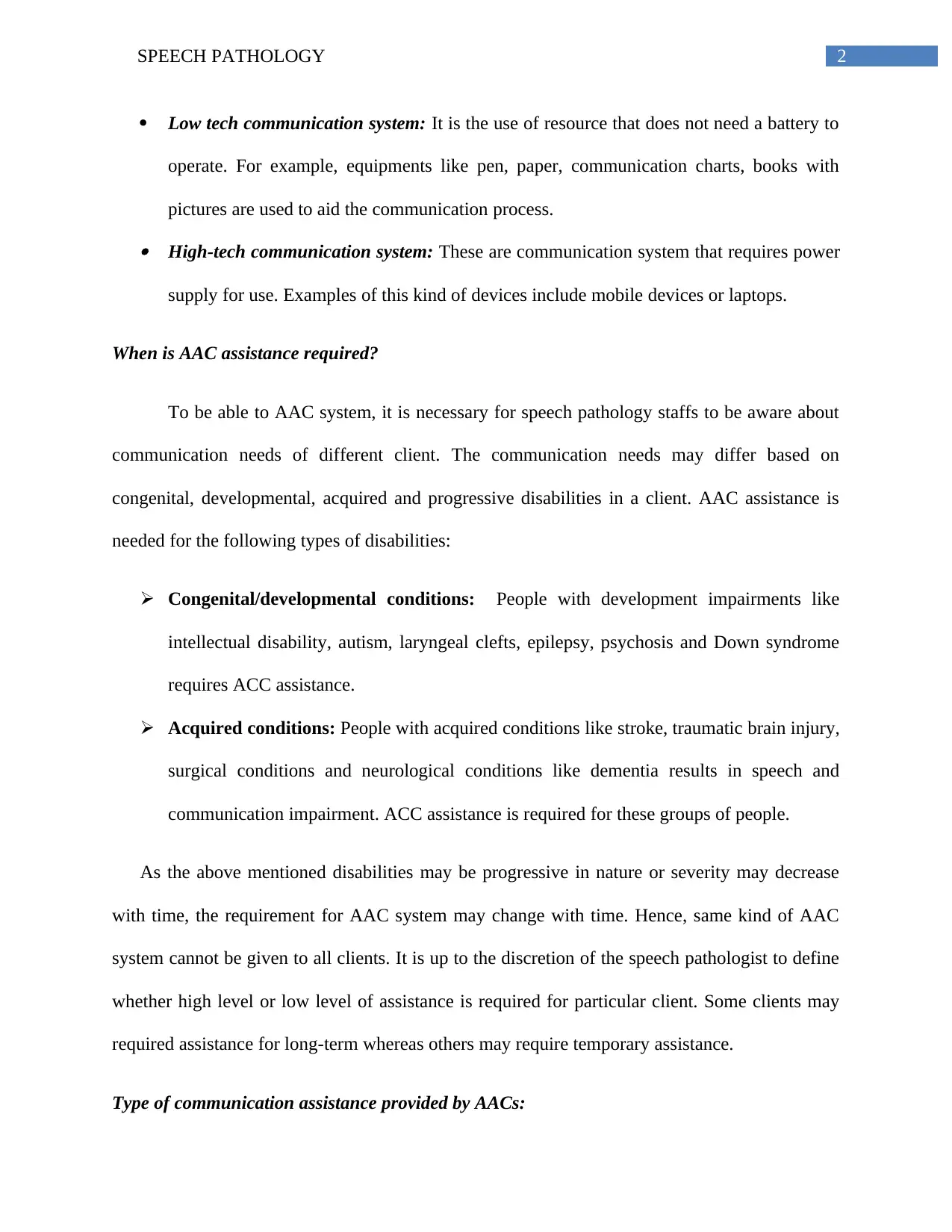
2SPEECH PATHOLOGY
Low tech communication system: It is the use of resource that does not need a battery to
operate. For example, equipments like pen, paper, communication charts, books with
pictures are used to aid the communication process. High-tech communication system: These are communication system that requires power
supply for use. Examples of this kind of devices include mobile devices or laptops.
When is AAC assistance required?
To be able to AAC system, it is necessary for speech pathology staffs to be aware about
communication needs of different client. The communication needs may differ based on
congenital, developmental, acquired and progressive disabilities in a client. AAC assistance is
needed for the following types of disabilities:
Congenital/developmental conditions: People with development impairments like
intellectual disability, autism, laryngeal clefts, epilepsy, psychosis and Down syndrome
requires ACC assistance.
Acquired conditions: People with acquired conditions like stroke, traumatic brain injury,
surgical conditions and neurological conditions like dementia results in speech and
communication impairment. ACC assistance is required for these groups of people.
As the above mentioned disabilities may be progressive in nature or severity may decrease
with time, the requirement for AAC system may change with time. Hence, same kind of AAC
system cannot be given to all clients. It is up to the discretion of the speech pathologist to define
whether high level or low level of assistance is required for particular client. Some clients may
required assistance for long-term whereas others may require temporary assistance.
Type of communication assistance provided by AACs:
Low tech communication system: It is the use of resource that does not need a battery to
operate. For example, equipments like pen, paper, communication charts, books with
pictures are used to aid the communication process. High-tech communication system: These are communication system that requires power
supply for use. Examples of this kind of devices include mobile devices or laptops.
When is AAC assistance required?
To be able to AAC system, it is necessary for speech pathology staffs to be aware about
communication needs of different client. The communication needs may differ based on
congenital, developmental, acquired and progressive disabilities in a client. AAC assistance is
needed for the following types of disabilities:
Congenital/developmental conditions: People with development impairments like
intellectual disability, autism, laryngeal clefts, epilepsy, psychosis and Down syndrome
requires ACC assistance.
Acquired conditions: People with acquired conditions like stroke, traumatic brain injury,
surgical conditions and neurological conditions like dementia results in speech and
communication impairment. ACC assistance is required for these groups of people.
As the above mentioned disabilities may be progressive in nature or severity may decrease
with time, the requirement for AAC system may change with time. Hence, same kind of AAC
system cannot be given to all clients. It is up to the discretion of the speech pathologist to define
whether high level or low level of assistance is required for particular client. Some clients may
required assistance for long-term whereas others may require temporary assistance.
Type of communication assistance provided by AACs:
⊘ This is a preview!⊘
Do you want full access?
Subscribe today to unlock all pages.

Trusted by 1+ million students worldwide
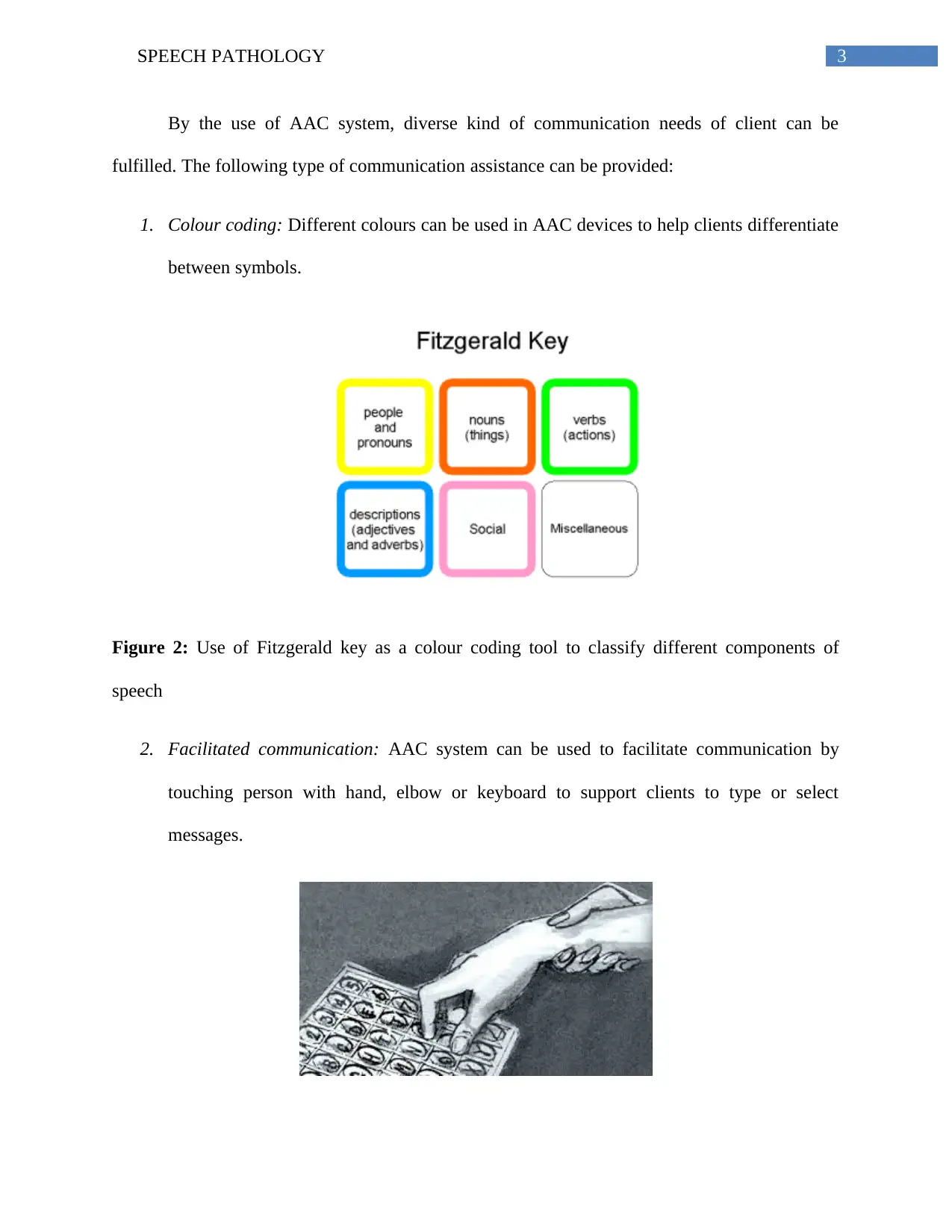
3SPEECH PATHOLOGY
By the use of AAC system, diverse kind of communication needs of client can be
fulfilled. The following type of communication assistance can be provided:
1. Colour coding: Different colours can be used in AAC devices to help clients differentiate
between symbols.
Figure 2: Use of Fitzgerald key as a colour coding tool to classify different components of
speech
2. Facilitated communication: AAC system can be used to facilitate communication by
touching person with hand, elbow or keyboard to support clients to type or select
messages.
By the use of AAC system, diverse kind of communication needs of client can be
fulfilled. The following type of communication assistance can be provided:
1. Colour coding: Different colours can be used in AAC devices to help clients differentiate
between symbols.
Figure 2: Use of Fitzgerald key as a colour coding tool to classify different components of
speech
2. Facilitated communication: AAC system can be used to facilitate communication by
touching person with hand, elbow or keyboard to support clients to type or select
messages.
Paraphrase This Document
Need a fresh take? Get an instant paraphrase of this document with our AI Paraphraser
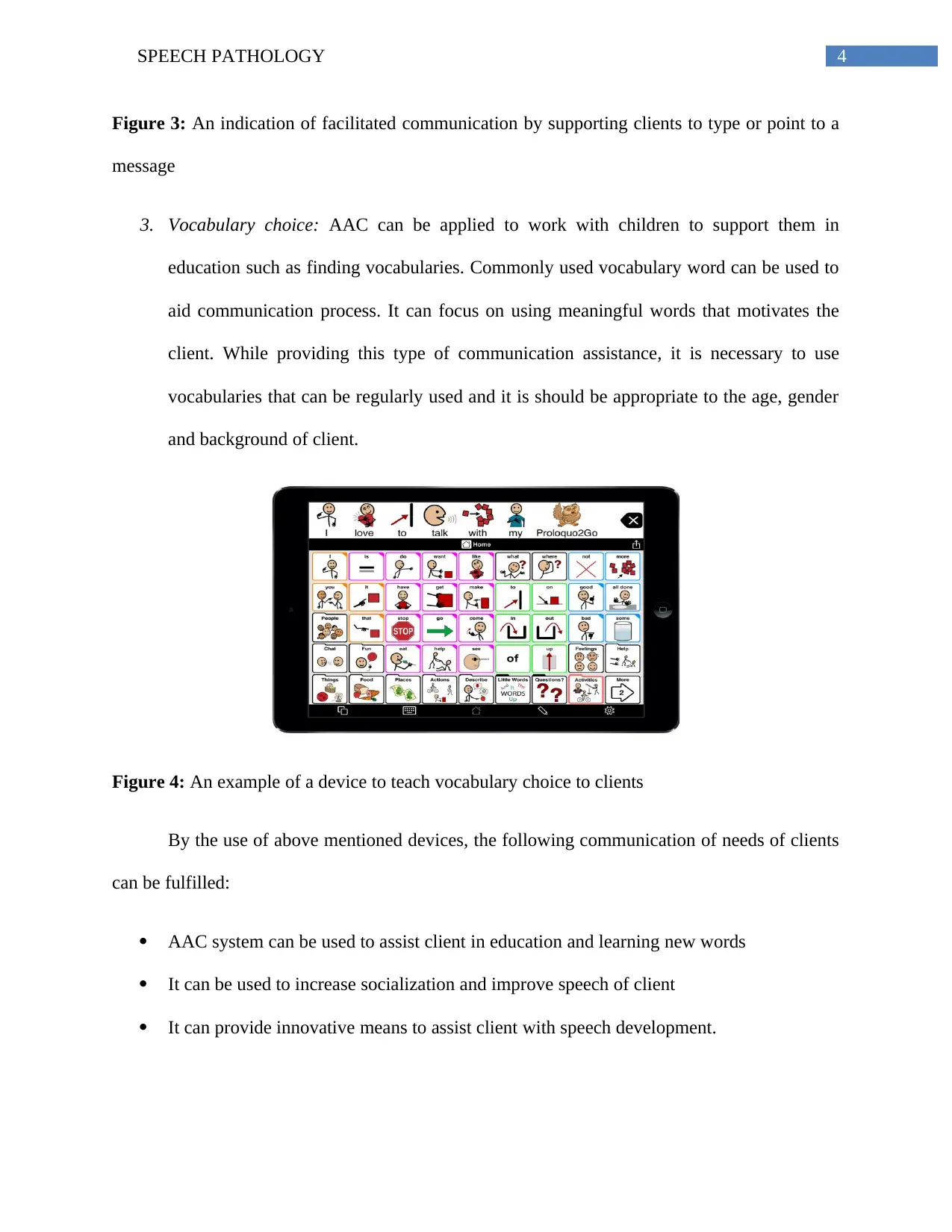
4SPEECH PATHOLOGY
Figure 3: An indication of facilitated communication by supporting clients to type or point to a
message
3. Vocabulary choice: AAC can be applied to work with children to support them in
education such as finding vocabularies. Commonly used vocabulary word can be used to
aid communication process. It can focus on using meaningful words that motivates the
client. While providing this type of communication assistance, it is necessary to use
vocabularies that can be regularly used and it is should be appropriate to the age, gender
and background of client.
Figure 4: An example of a device to teach vocabulary choice to clients
By the use of above mentioned devices, the following communication of needs of clients
can be fulfilled:
AAC system can be used to assist client in education and learning new words
It can be used to increase socialization and improve speech of client
It can provide innovative means to assist client with speech development.
Figure 3: An indication of facilitated communication by supporting clients to type or point to a
message
3. Vocabulary choice: AAC can be applied to work with children to support them in
education such as finding vocabularies. Commonly used vocabulary word can be used to
aid communication process. It can focus on using meaningful words that motivates the
client. While providing this type of communication assistance, it is necessary to use
vocabularies that can be regularly used and it is should be appropriate to the age, gender
and background of client.
Figure 4: An example of a device to teach vocabulary choice to clients
By the use of above mentioned devices, the following communication of needs of clients
can be fulfilled:
AAC system can be used to assist client in education and learning new words
It can be used to increase socialization and improve speech of client
It can provide innovative means to assist client with speech development.
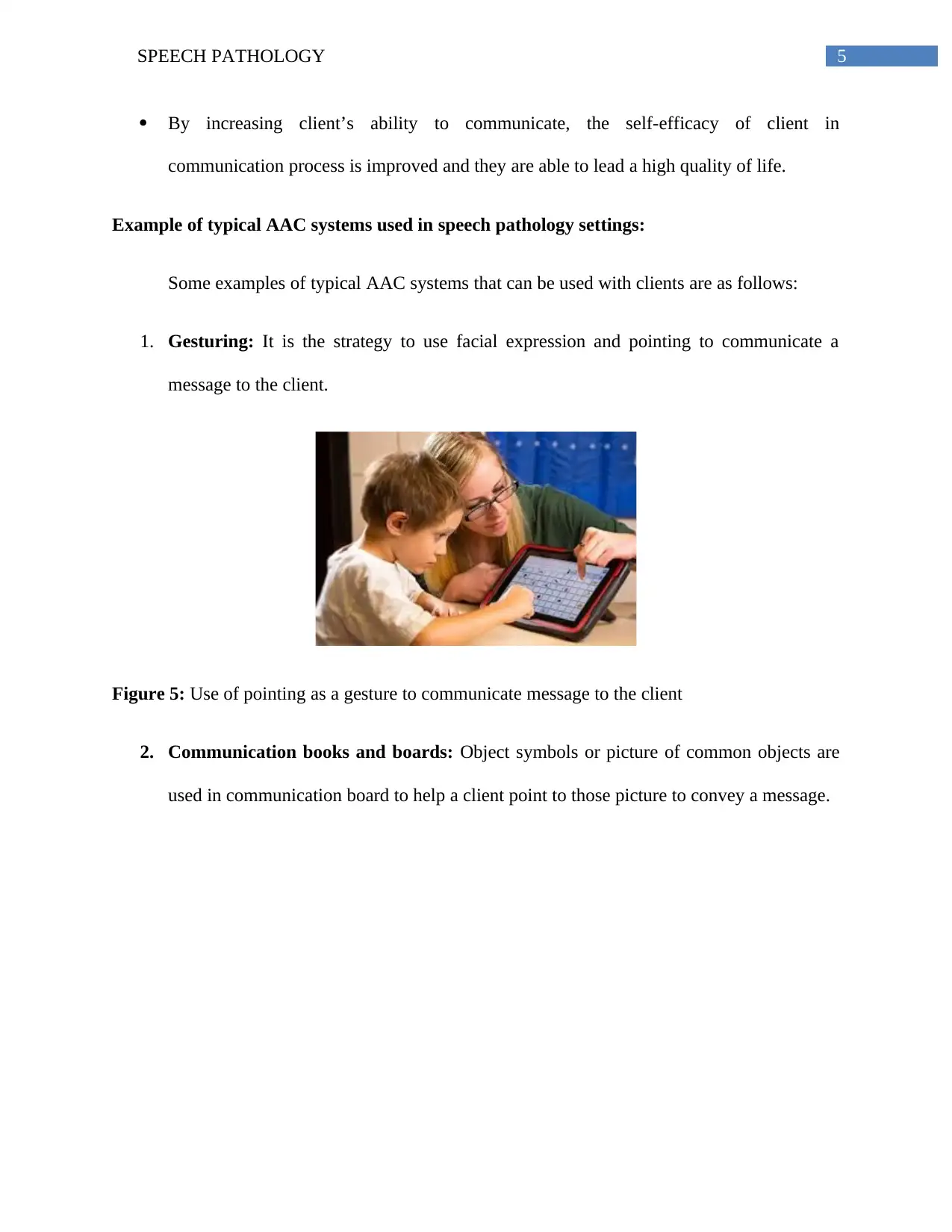
5SPEECH PATHOLOGY
By increasing client’s ability to communicate, the self-efficacy of client in
communication process is improved and they are able to lead a high quality of life.
Example of typical AAC systems used in speech pathology settings:
Some examples of typical AAC systems that can be used with clients are as follows:
1. Gesturing: It is the strategy to use facial expression and pointing to communicate a
message to the client.
Figure 5: Use of pointing as a gesture to communicate message to the client
2. Communication books and boards: Object symbols or picture of common objects are
used in communication board to help a client point to those picture to convey a message.
By increasing client’s ability to communicate, the self-efficacy of client in
communication process is improved and they are able to lead a high quality of life.
Example of typical AAC systems used in speech pathology settings:
Some examples of typical AAC systems that can be used with clients are as follows:
1. Gesturing: It is the strategy to use facial expression and pointing to communicate a
message to the client.
Figure 5: Use of pointing as a gesture to communicate message to the client
2. Communication books and boards: Object symbols or picture of common objects are
used in communication board to help a client point to those picture to convey a message.
⊘ This is a preview!⊘
Do you want full access?
Subscribe today to unlock all pages.

Trusted by 1+ million students worldwide
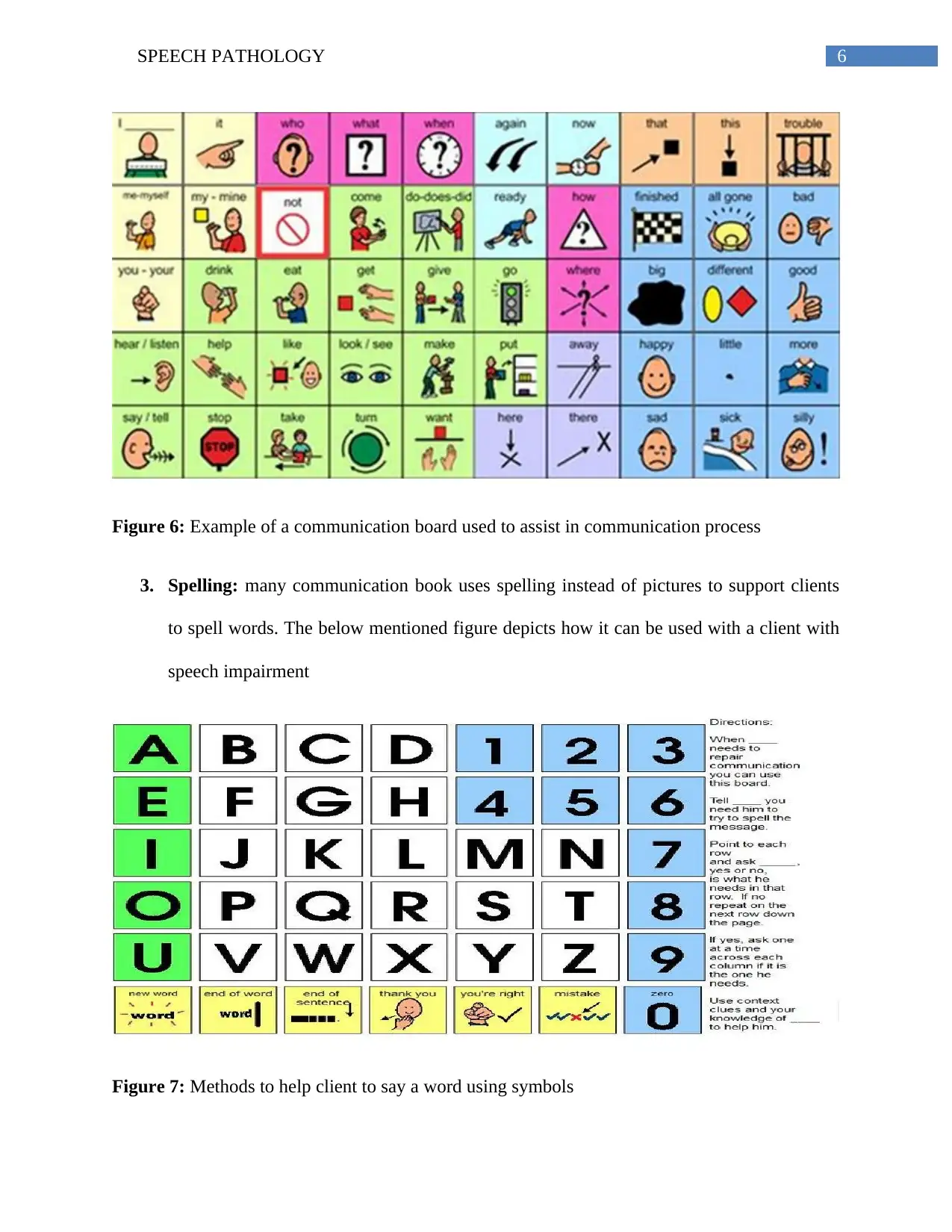
6SPEECH PATHOLOGY
Figure 6: Example of a communication board used to assist in communication process
3. Spelling: many communication book uses spelling instead of pictures to support clients
to spell words. The below mentioned figure depicts how it can be used with a client with
speech impairment
Figure 7: Methods to help client to say a word using symbols
Figure 6: Example of a communication board used to assist in communication process
3. Spelling: many communication book uses spelling instead of pictures to support clients
to spell words. The below mentioned figure depicts how it can be used with a client with
speech impairment
Figure 7: Methods to help client to say a word using symbols
Paraphrase This Document
Need a fresh take? Get an instant paraphrase of this document with our AI Paraphraser
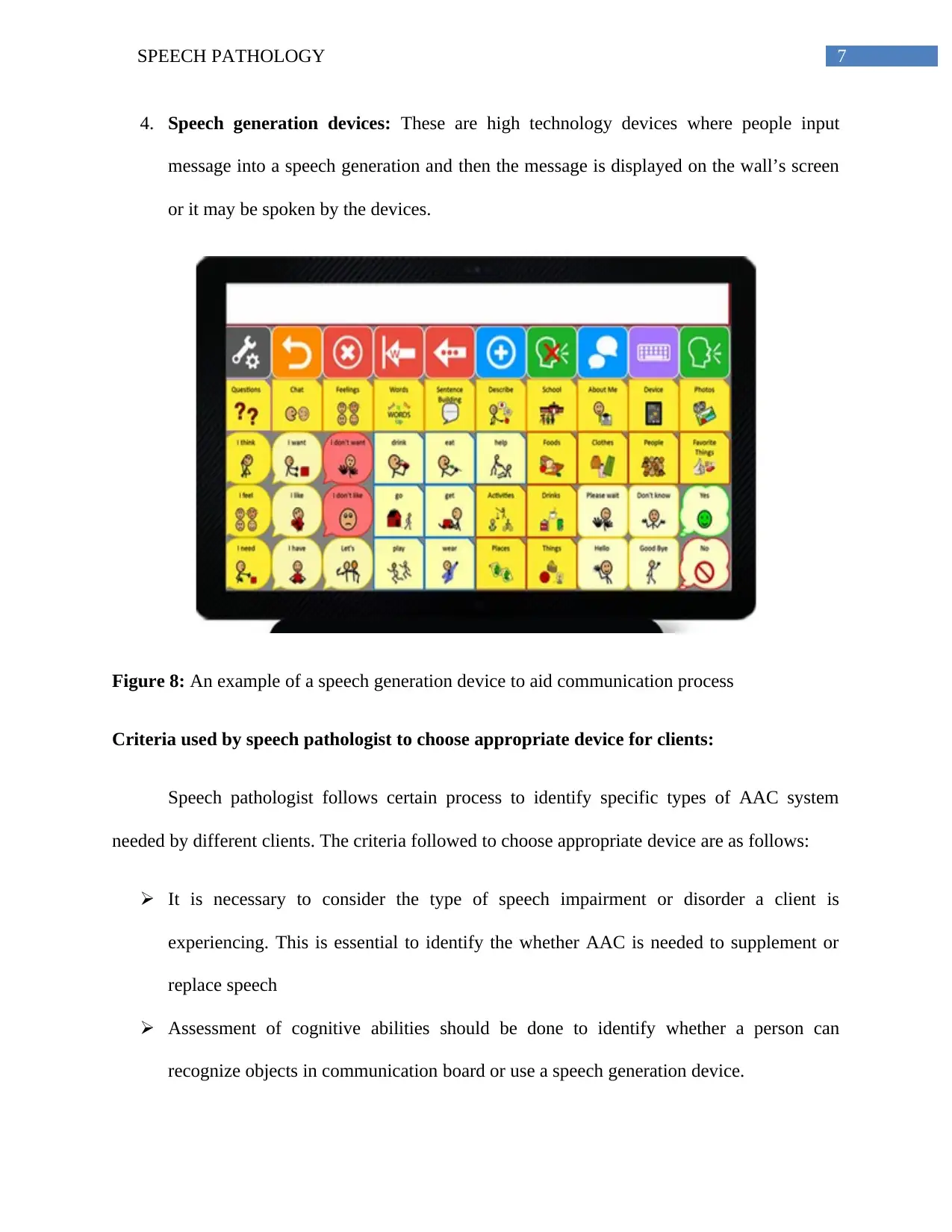
7SPEECH PATHOLOGY
4. Speech generation devices: These are high technology devices where people input
message into a speech generation and then the message is displayed on the wall’s screen
or it may be spoken by the devices.
Figure 8: An example of a speech generation device to aid communication process
Criteria used by speech pathologist to choose appropriate device for clients:
Speech pathologist follows certain process to identify specific types of AAC system
needed by different clients. The criteria followed to choose appropriate device are as follows:
It is necessary to consider the type of speech impairment or disorder a client is
experiencing. This is essential to identify the whether AAC is needed to supplement or
replace speech
Assessment of cognitive abilities should be done to identify whether a person can
recognize objects in communication board or use a speech generation device.
4. Speech generation devices: These are high technology devices where people input
message into a speech generation and then the message is displayed on the wall’s screen
or it may be spoken by the devices.
Figure 8: An example of a speech generation device to aid communication process
Criteria used by speech pathologist to choose appropriate device for clients:
Speech pathologist follows certain process to identify specific types of AAC system
needed by different clients. The criteria followed to choose appropriate device are as follows:
It is necessary to consider the type of speech impairment or disorder a client is
experiencing. This is essential to identify the whether AAC is needed to supplement or
replace speech
Assessment of cognitive abilities should be done to identify whether a person can
recognize objects in communication board or use a speech generation device.
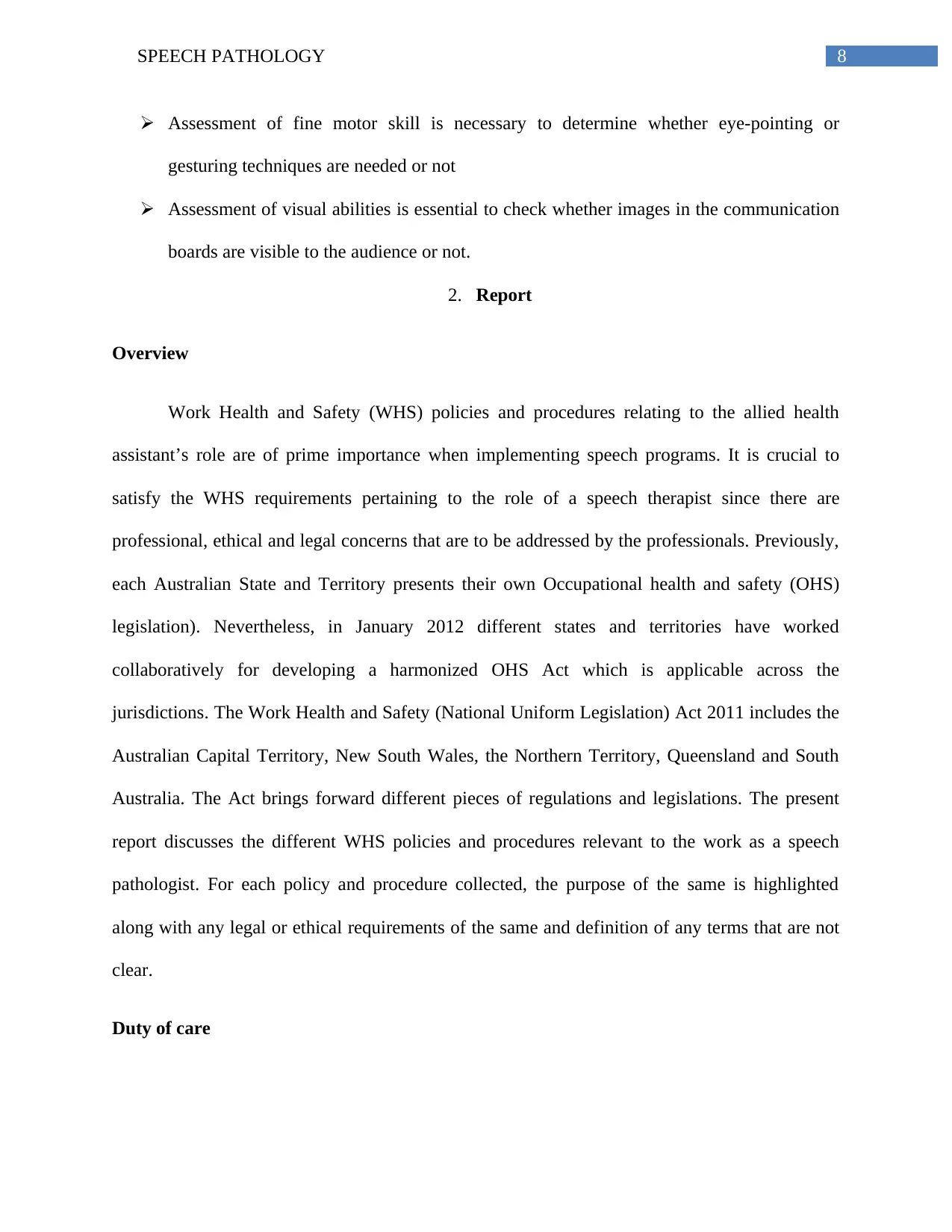
8SPEECH PATHOLOGY
Assessment of fine motor skill is necessary to determine whether eye-pointing or
gesturing techniques are needed or not
Assessment of visual abilities is essential to check whether images in the communication
boards are visible to the audience or not.
2. Report
Overview
Work Health and Safety (WHS) policies and procedures relating to the allied health
assistant’s role are of prime importance when implementing speech programs. It is crucial to
satisfy the WHS requirements pertaining to the role of a speech therapist since there are
professional, ethical and legal concerns that are to be addressed by the professionals. Previously,
each Australian State and Territory presents their own Occupational health and safety (OHS)
legislation). Nevertheless, in January 2012 different states and territories have worked
collaboratively for developing a harmonized OHS Act which is applicable across the
jurisdictions. The Work Health and Safety (National Uniform Legislation) Act 2011 includes the
Australian Capital Territory, New South Wales, the Northern Territory, Queensland and South
Australia. The Act brings forward different pieces of regulations and legislations. The present
report discusses the different WHS policies and procedures relevant to the work as a speech
pathologist. For each policy and procedure collected, the purpose of the same is highlighted
along with any legal or ethical requirements of the same and definition of any terms that are not
clear.
Duty of care
Assessment of fine motor skill is necessary to determine whether eye-pointing or
gesturing techniques are needed or not
Assessment of visual abilities is essential to check whether images in the communication
boards are visible to the audience or not.
2. Report
Overview
Work Health and Safety (WHS) policies and procedures relating to the allied health
assistant’s role are of prime importance when implementing speech programs. It is crucial to
satisfy the WHS requirements pertaining to the role of a speech therapist since there are
professional, ethical and legal concerns that are to be addressed by the professionals. Previously,
each Australian State and Territory presents their own Occupational health and safety (OHS)
legislation). Nevertheless, in January 2012 different states and territories have worked
collaboratively for developing a harmonized OHS Act which is applicable across the
jurisdictions. The Work Health and Safety (National Uniform Legislation) Act 2011 includes the
Australian Capital Territory, New South Wales, the Northern Territory, Queensland and South
Australia. The Act brings forward different pieces of regulations and legislations. The present
report discusses the different WHS policies and procedures relevant to the work as a speech
pathologist. For each policy and procedure collected, the purpose of the same is highlighted
along with any legal or ethical requirements of the same and definition of any terms that are not
clear.
Duty of care
⊘ This is a preview!⊘
Do you want full access?
Subscribe today to unlock all pages.

Trusted by 1+ million students worldwide
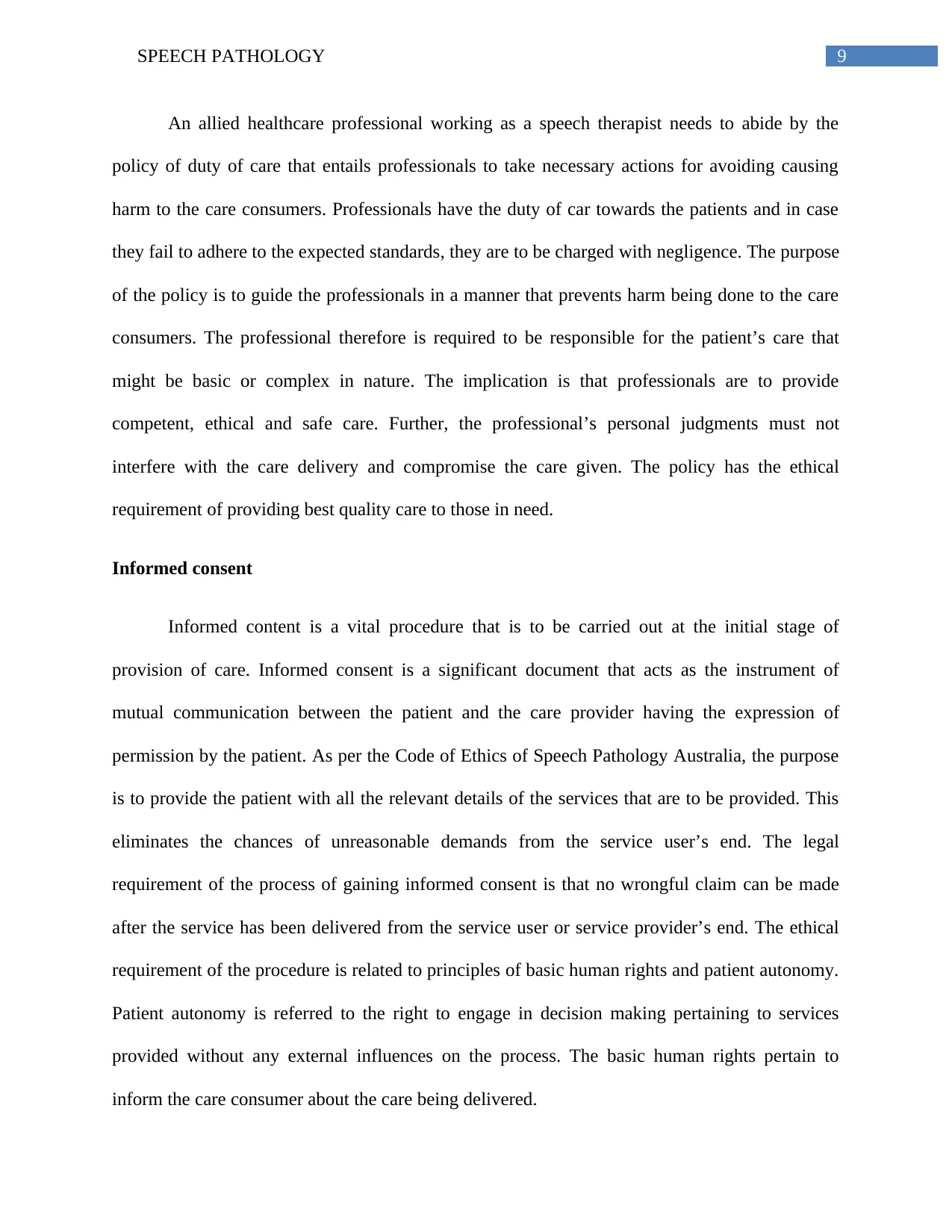
9SPEECH PATHOLOGY
An allied healthcare professional working as a speech therapist needs to abide by the
policy of duty of care that entails professionals to take necessary actions for avoiding causing
harm to the care consumers. Professionals have the duty of car towards the patients and in case
they fail to adhere to the expected standards, they are to be charged with negligence. The purpose
of the policy is to guide the professionals in a manner that prevents harm being done to the care
consumers. The professional therefore is required to be responsible for the patient’s care that
might be basic or complex in nature. The implication is that professionals are to provide
competent, ethical and safe care. Further, the professional’s personal judgments must not
interfere with the care delivery and compromise the care given. The policy has the ethical
requirement of providing best quality care to those in need.
Informed consent
Informed content is a vital procedure that is to be carried out at the initial stage of
provision of care. Informed consent is a significant document that acts as the instrument of
mutual communication between the patient and the care provider having the expression of
permission by the patient. As per the Code of Ethics of Speech Pathology Australia, the purpose
is to provide the patient with all the relevant details of the services that are to be provided. This
eliminates the chances of unreasonable demands from the service user’s end. The legal
requirement of the process of gaining informed consent is that no wrongful claim can be made
after the service has been delivered from the service user or service provider’s end. The ethical
requirement of the procedure is related to principles of basic human rights and patient autonomy.
Patient autonomy is referred to the right to engage in decision making pertaining to services
provided without any external influences on the process. The basic human rights pertain to
inform the care consumer about the care being delivered.
An allied healthcare professional working as a speech therapist needs to abide by the
policy of duty of care that entails professionals to take necessary actions for avoiding causing
harm to the care consumers. Professionals have the duty of car towards the patients and in case
they fail to adhere to the expected standards, they are to be charged with negligence. The purpose
of the policy is to guide the professionals in a manner that prevents harm being done to the care
consumers. The professional therefore is required to be responsible for the patient’s care that
might be basic or complex in nature. The implication is that professionals are to provide
competent, ethical and safe care. Further, the professional’s personal judgments must not
interfere with the care delivery and compromise the care given. The policy has the ethical
requirement of providing best quality care to those in need.
Informed consent
Informed content is a vital procedure that is to be carried out at the initial stage of
provision of care. Informed consent is a significant document that acts as the instrument of
mutual communication between the patient and the care provider having the expression of
permission by the patient. As per the Code of Ethics of Speech Pathology Australia, the purpose
is to provide the patient with all the relevant details of the services that are to be provided. This
eliminates the chances of unreasonable demands from the service user’s end. The legal
requirement of the process of gaining informed consent is that no wrongful claim can be made
after the service has been delivered from the service user or service provider’s end. The ethical
requirement of the procedure is related to principles of basic human rights and patient autonomy.
Patient autonomy is referred to the right to engage in decision making pertaining to services
provided without any external influences on the process. The basic human rights pertain to
inform the care consumer about the care being delivered.
Paraphrase This Document
Need a fresh take? Get an instant paraphrase of this document with our AI Paraphraser
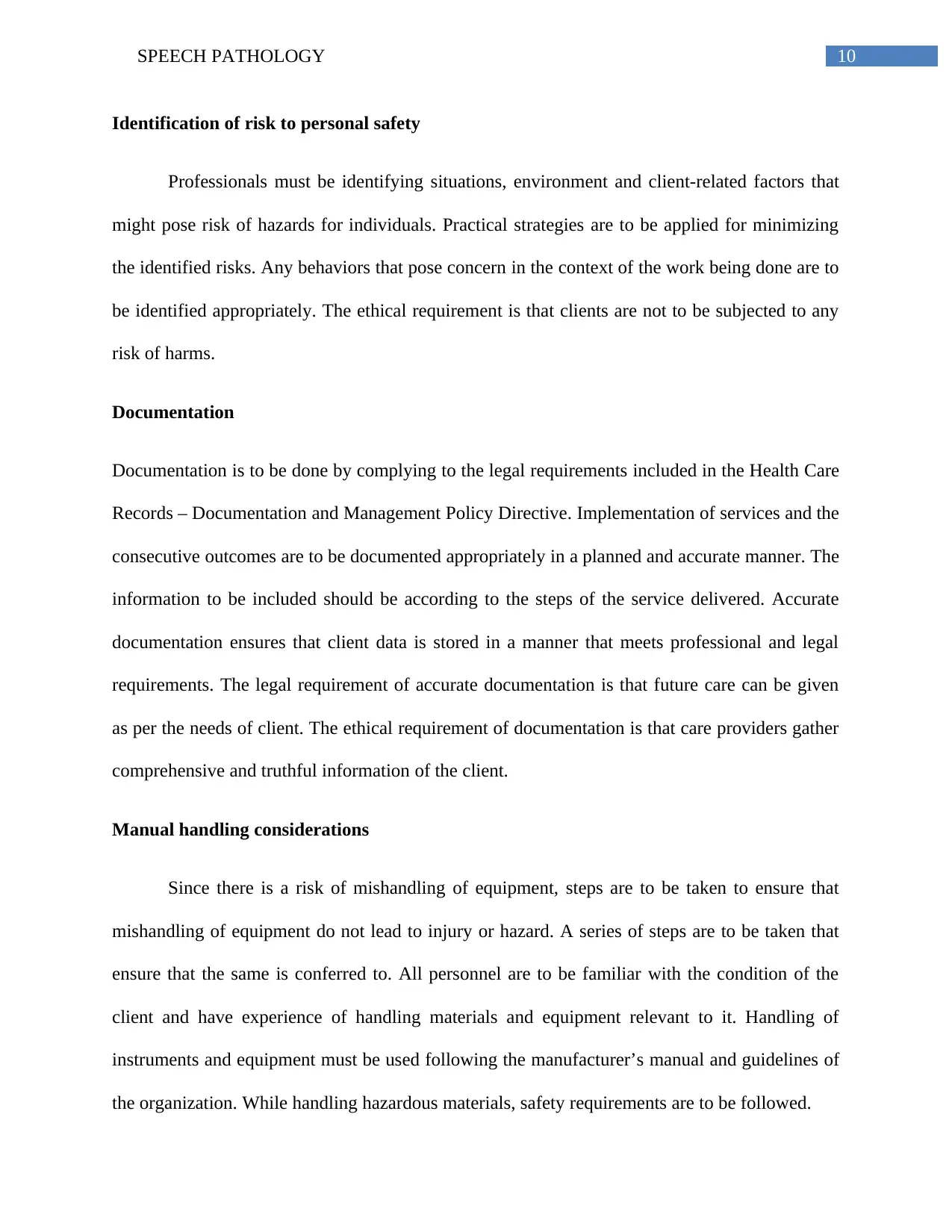
10SPEECH PATHOLOGY
Identification of risk to personal safety
Professionals must be identifying situations, environment and client-related factors that
might pose risk of hazards for individuals. Practical strategies are to be applied for minimizing
the identified risks. Any behaviors that pose concern in the context of the work being done are to
be identified appropriately. The ethical requirement is that clients are not to be subjected to any
risk of harms.
Documentation
Documentation is to be done by complying to the legal requirements included in the Health Care
Records – Documentation and Management Policy Directive. Implementation of services and the
consecutive outcomes are to be documented appropriately in a planned and accurate manner. The
information to be included should be according to the steps of the service delivered. Accurate
documentation ensures that client data is stored in a manner that meets professional and legal
requirements. The legal requirement of accurate documentation is that future care can be given
as per the needs of client. The ethical requirement of documentation is that care providers gather
comprehensive and truthful information of the client.
Manual handling considerations
Since there is a risk of mishandling of equipment, steps are to be taken to ensure that
mishandling of equipment do not lead to injury or hazard. A series of steps are to be taken that
ensure that the same is conferred to. All personnel are to be familiar with the condition of the
client and have experience of handling materials and equipment relevant to it. Handling of
instruments and equipment must be used following the manufacturer’s manual and guidelines of
the organization. While handling hazardous materials, safety requirements are to be followed.
Identification of risk to personal safety
Professionals must be identifying situations, environment and client-related factors that
might pose risk of hazards for individuals. Practical strategies are to be applied for minimizing
the identified risks. Any behaviors that pose concern in the context of the work being done are to
be identified appropriately. The ethical requirement is that clients are not to be subjected to any
risk of harms.
Documentation
Documentation is to be done by complying to the legal requirements included in the Health Care
Records – Documentation and Management Policy Directive. Implementation of services and the
consecutive outcomes are to be documented appropriately in a planned and accurate manner. The
information to be included should be according to the steps of the service delivered. Accurate
documentation ensures that client data is stored in a manner that meets professional and legal
requirements. The legal requirement of accurate documentation is that future care can be given
as per the needs of client. The ethical requirement of documentation is that care providers gather
comprehensive and truthful information of the client.
Manual handling considerations
Since there is a risk of mishandling of equipment, steps are to be taken to ensure that
mishandling of equipment do not lead to injury or hazard. A series of steps are to be taken that
ensure that the same is conferred to. All personnel are to be familiar with the condition of the
client and have experience of handling materials and equipment relevant to it. Handling of
instruments and equipment must be used following the manufacturer’s manual and guidelines of
the organization. While handling hazardous materials, safety requirements are to be followed.
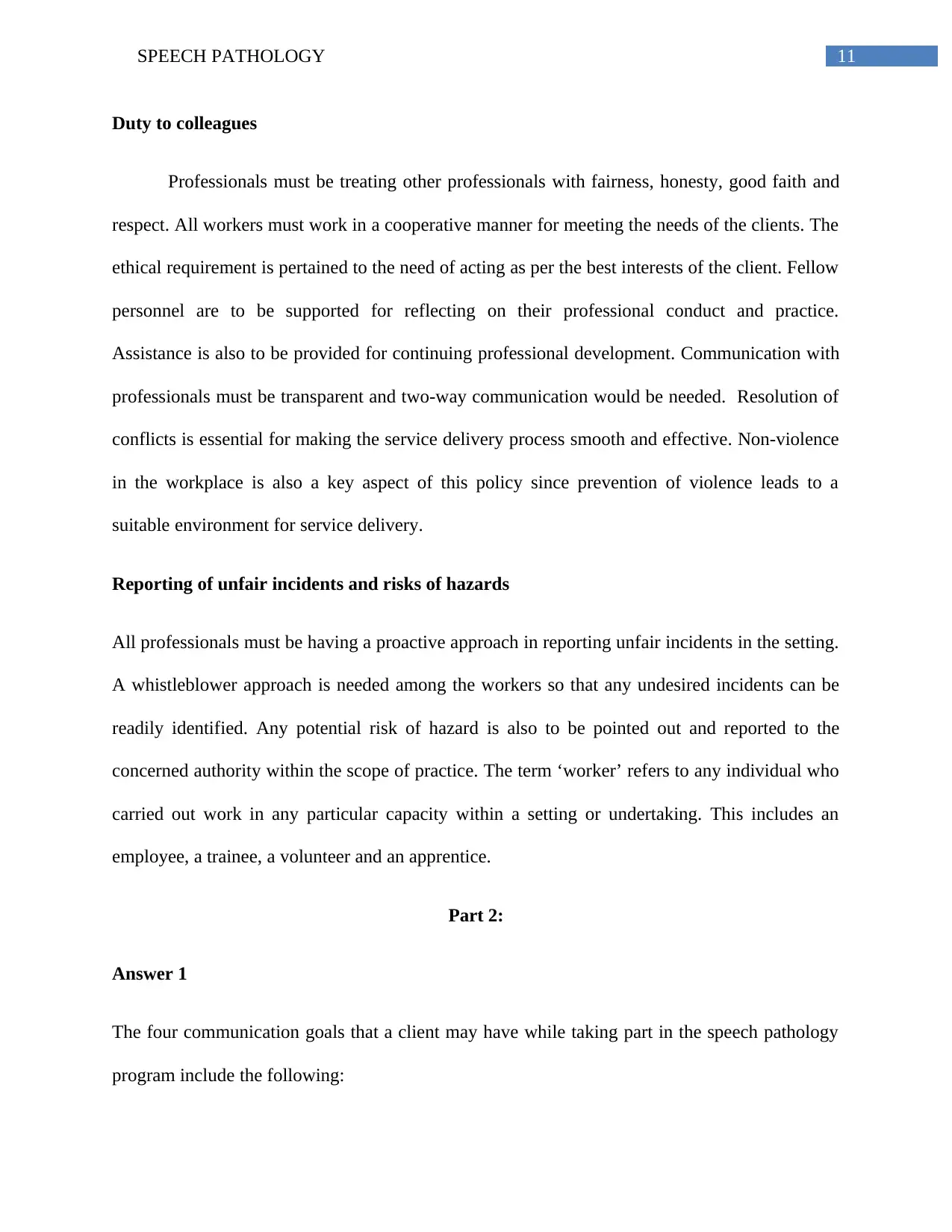
11SPEECH PATHOLOGY
Duty to colleagues
Professionals must be treating other professionals with fairness, honesty, good faith and
respect. All workers must work in a cooperative manner for meeting the needs of the clients. The
ethical requirement is pertained to the need of acting as per the best interests of the client. Fellow
personnel are to be supported for reflecting on their professional conduct and practice.
Assistance is also to be provided for continuing professional development. Communication with
professionals must be transparent and two-way communication would be needed. Resolution of
conflicts is essential for making the service delivery process smooth and effective. Non-violence
in the workplace is also a key aspect of this policy since prevention of violence leads to a
suitable environment for service delivery.
Reporting of unfair incidents and risks of hazards
All professionals must be having a proactive approach in reporting unfair incidents in the setting.
A whistleblower approach is needed among the workers so that any undesired incidents can be
readily identified. Any potential risk of hazard is also to be pointed out and reported to the
concerned authority within the scope of practice. The term ‘worker’ refers to any individual who
carried out work in any particular capacity within a setting or undertaking. This includes an
employee, a trainee, a volunteer and an apprentice.
Part 2:
Answer 1
The four communication goals that a client may have while taking part in the speech pathology
program include the following:
Duty to colleagues
Professionals must be treating other professionals with fairness, honesty, good faith and
respect. All workers must work in a cooperative manner for meeting the needs of the clients. The
ethical requirement is pertained to the need of acting as per the best interests of the client. Fellow
personnel are to be supported for reflecting on their professional conduct and practice.
Assistance is also to be provided for continuing professional development. Communication with
professionals must be transparent and two-way communication would be needed. Resolution of
conflicts is essential for making the service delivery process smooth and effective. Non-violence
in the workplace is also a key aspect of this policy since prevention of violence leads to a
suitable environment for service delivery.
Reporting of unfair incidents and risks of hazards
All professionals must be having a proactive approach in reporting unfair incidents in the setting.
A whistleblower approach is needed among the workers so that any undesired incidents can be
readily identified. Any potential risk of hazard is also to be pointed out and reported to the
concerned authority within the scope of practice. The term ‘worker’ refers to any individual who
carried out work in any particular capacity within a setting or undertaking. This includes an
employee, a trainee, a volunteer and an apprentice.
Part 2:
Answer 1
The four communication goals that a client may have while taking part in the speech pathology
program include the following:
⊘ This is a preview!⊘
Do you want full access?
Subscribe today to unlock all pages.

Trusted by 1+ million students worldwide
1 out of 22
Related Documents
Your All-in-One AI-Powered Toolkit for Academic Success.
+13062052269
info@desklib.com
Available 24*7 on WhatsApp / Email
![[object Object]](/_next/static/media/star-bottom.7253800d.svg)
Unlock your academic potential
Copyright © 2020–2025 A2Z Services. All Rights Reserved. Developed and managed by ZUCOL.



